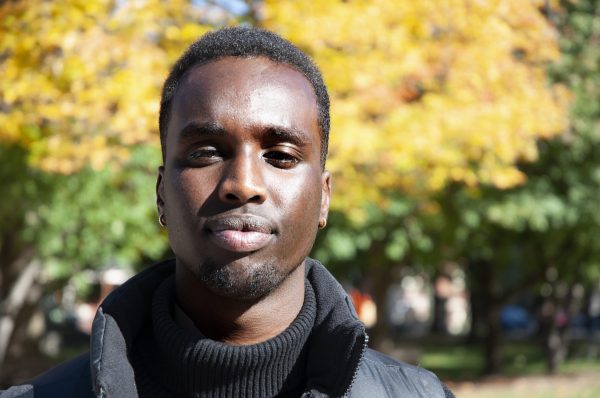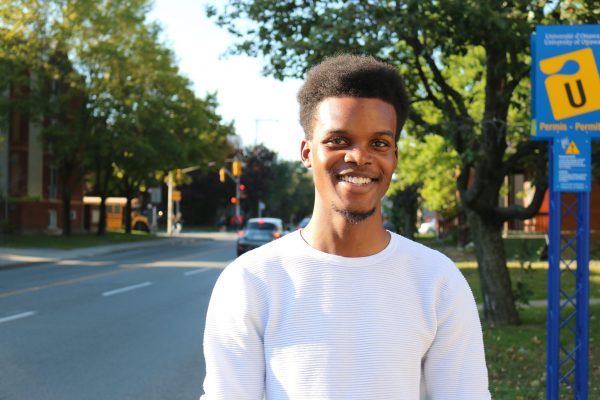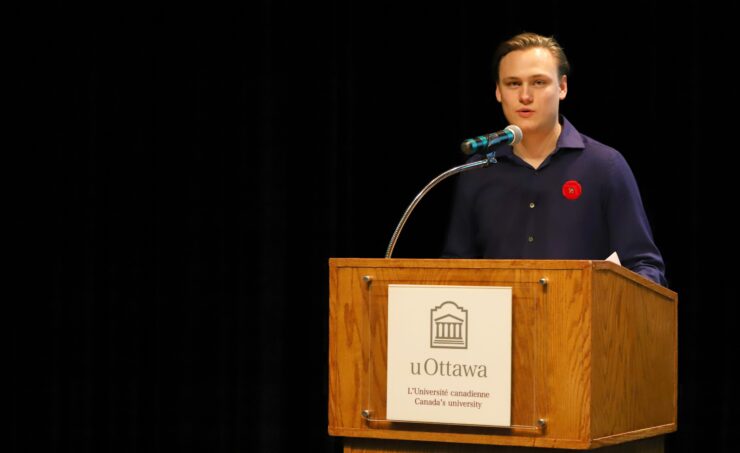Independent investigation comes after Black student carded, handcuffed by Protection Services in June 2019
The University of Ottawa should collect race-based data on its student population, improve training for Protection Services officers, and continue making changes to policies governing security on campus, according to the findings of an independent investigation launched after a Black student was carded and handcuffed by campus security in June 2019.
The 34-page report by investigator and former vice-chair of the Ontario Human Rights Tribunal Esi Codjoe, released on Feb. 18 and dated Jan. 28, was sparked after Jamal Koulmiye-Boyce, a Black conflict studies and human rights student and vice-president of his program’s student association, was detained by campus security for over two hours on June 12.
Esi Codjoe’s second rep… by Matt Gergyek on Scribd
Boyce recounted the incident in a Twitter thread on June 13, an experience he called “extremely humiliating,” “blatant racism,” and “physical, mental, emotional violence.”
Koulmiye-Boyce was skateboarding on campus at the time and complied with officers’ to stop, but when he could not produce his student identification card — which was in his office on campus — Protection Services officers detained him under the Trespass to Property Act (TPA). Police were called but Koulmiye-Boyce was released without charges.

In her first report from October 2019, which focused solely on the June incident, Codjoe found that Koulmiye-Boyce faced racial discrimination. Race, insufficient training, and outdated procedures played a role in the way Koulmiye-Boyce was treated, Codjoe determined.
For her second report, Codjoe was asked to look at the broader policies governing Protection Services on campus, including university procedures and the TPA, examining whether they are up to date and void of systemic impacts on racialized communities.
U of O should begin collecting race-based data on students, report concludes
Codjoe examined Protection Services incident report data from 2014-18 and the first seven months of 2019, with 426 use of force, trespass notices, or use of force and trespass notices recorded in that timeframe, including both students and non-students.
While Codjoe said race was rarely mentioned in those incident reports, she reported finding a trend that could be linked to racialized people: Of the 480 names in the incident reports, 243 of them, or just above 50 per cent, were not traditionally Western European in origin.
Codjoe wrote she “inferred that there is a reasonable probability that names that appear to be African, East Asian, South Asian, South American or Muslim most likely belong to persons who are ethnically Black, East Asian, South Asian, are from the Middle East or are Latinx.”
In her report, Codjoe wrote that these projected numbers do not fall in line with the most recent Ottawa census data from 2016, which found 26 per cent of the city’s population is racialized.
“The data suggests that racialized members of the university community could be over-represented in the number of persons with whom the (Protection Services officers) interact with in certain contexts; namely in the application of the use of force and trespass notices,” Codjoe wrote. She noted the demographics of the university population could also differ from that of the city.
Meanwhile, of the 426 cases Codjoe probed, 14 explicitly mentioned a person involved was Black or African American. On the whole, Codjoe found these cases were “unremarkable,” but she highlighted one incident in her report when a U of O employee called Protection Services to report a “suspicious Black person in a university building” who “does not look like a student.”
Codjoe wrote that Protection Services officers “taking action based on this description of how someone looked is potentially problematic,” noting there is no standard “student ‘look.’ ”
“The notion that someone does not look like the sort of person who belongs can be a proxy for discriminatory mindsets and can lead to discriminatory treatment such as racial profiling.”
Codjoe encouraged the administration to begin collecting race-based data on students “to understand the university population and its needs.”
Doing so would “facilitate an evidence-based understanding of which community members (Protection Services officers) most frequently engage with,” and would also show whether racialized peoples are over-represented in interactions with Protection Services officers, Codjoe wrote.
University should continue making changes to security policies, report says
According to Codoe’s report, the university procedure for addressing trespassing needs updating. Codjoe wrote that the procedure should include a clear definition of what constitutes trespassing, that “should reflect the reality of the university’s public/private nature.”
“While it is true that the university is technically private property, much of its property is ordinarily made available to the public,” Codjoe writes. “Given this reality, it is likely that many individuals technically unknowingly ‘trespass’ on university property every day.”
Codjoe says the use of the term “suspicious individuals” in the trespassing procedure is also problematic, especially because the term is not defined, meaning it could be applied to people in violation of the Ontario Human Rights Code.
“Two historically marginalized communities that are covered by the (Ontario Human Rights) Code often have the term suspicious applied to them. Namely, Black and Indigenous people engaging in activities such as shopping, and persons who are or who appear to be Muslim while flying,” wrote Codjoe.
“Persons from these communities are sometimes deemed to be suspicious simply by virtue of belonging to these communities.”
Codjoe also highlighted the findings from a provincial task force from 1987 that examined equity issues and trespassing, with a focus on the TPA, which remain “as relevant now as they were 33 years ago.” She encourages the university to incorporate those findings into their own policies.
One of the task force’s conclusions, for example, was that the “TPA creates the potential for the discriminatory enforcement of its terms against racialized community members” as “an owner can require a person to leave the property for any reason or no reason at all.”
“This would mean the university’s right to exclude persons from its premises would have more reasonable limits than those outlined in the statute,” wrote Codjoe.
Codjoe said the university should continue building on the changes it made to Policy 33, which governs security on campus.
Under the interim directive introduced at the start of the fall semester, officers must explain why they’re requesting identification and people can refuse to provide identification unless failure to do so compromises an individual’s safety. Identification “must never be requested randomly and arbitrarily and should be Protection Services’ routine practice,” the directive reads.
The university should also train officers on applying “critical thinking skills” when considering using force, according to Codjoe.
“Part of that training should involve empathy training, and how to identify what a (Protection Services officer) knows or does not know in an interaction with a community member,” wrote Codjoe.
U of O should improve training for Protection Services officers, Codjoe recommends
The administration should provide ongoing, expert training to Protection Services officers on a number of topics related to marginalized communities, which should occur at least yearly and be three hours long at the minimum, Codjoe recommended.
“Such training could include interactive empathy training, equity, diversity and inclusion training, and training on critical race theory,” wrote Codjoe, adding officers should be evaluated on the effectiveness of this training yearly.
Codjoe pointed to potential training gaps in her first report as well.
“Part of the reason why the … (June) incident occurred is because the (Protection Services officers) have inadequate training on diversity issues,” Codjoe wrote in the October report. “It is more likely than not that the (officers) are not receiving any nuanced, or up to date training on issues pertaining to race, including racial discrimination.”
U of O president Jacques Frémont “accepted the conclusion of the report and committed the university to continuing efforts to address racism and discrimination,” the administration said in a statement.
“The university has begun some good work around ensuring that it consults with its communities and transforms its policies and procedures,” Codjoe concluded. “If the above recommendations are adopted, it would likely engender a better-trained group of (Protection Services officers) who better understand and respect the community that they serve.”
Black student leaders urge administration to take immediate action
Dilaye Desta, the Black Student Leaders Association’s director of community engagement, commended Codjoe’s work but said she was “disappointed” that the recommendations in the report had already been outlined in a number of open letters, town halls, and meetings since the June incident.
“For them to reiterate what we’ve already been telling them for almost a year and to now have it formally written in a report as though this is a finding that they just discovered, was honestly quite disrespectful,” said Desta. “It just shows that (the administration) ignored everything that the community’s been telling them about issues that have been pervasive on campus.”
Desta said she was also frustrated that Codjoe was met with a lack of race-based data when analyzing interactions with Protection Services, highlighted in one of the report’s recommendations for the administration.
“It’s extremely frustrating to sit and wait to have this report come out to validate our experiences when students from previous years … have been saying that the university needs to have race-based data, we need to have numerical evidence that there’s systemic racism in all aspects of the university, not even just Protection Services.”
Wiliston Mason, a Black education student who was carded by a security officer in the residence building where he works and lives in September 2019, just weeks after the university introduced the interim directive to Policy 33 along with three other anti-racism measures, echoed Desta’s frustrations.

“The president has had these recommendations for months, and has done nothing,” said Mason. “People keep asking me, ‘Are you hopeful that things will change?’ and my response is always, ‘I definitely hope that it does, but I’m not going to hold my breath.’ ”
Mason added that Codjoe’s finding that racialized peoples may be overrepresented in interactions with Protection Services officers was not surprising.
“I don’t think that anybody is shocked by those figures,” said Mason “It’s saddening because that is the reality here at the university.”
Mason said he hoped the report would have included information on the number of racialized peoples employed by Protection Services as well.
“Is there diversity there, is there enough representation?” said Mason. “For me, as a Black man, I want to know that on my campus, there’s going to be Black security guards.”
Mason added that comprehensive training of officers and a rework of security policies are both crucial, urging the school to work with expert professors on campus.
Both Desta and Mason expressed concerns about the 23-person president’s advisory committee for anti-racism they are a part of, which also includes Koulmiye-Boyce, launched last semester. However, a number of Black students were not added to the committee until later in the year when open letters pushed for their inclusion.
“It’s kind of like a publicity stunt for the administration to make it seem as though they’re trying to make changes,” said Desta. “But as you can see, it’s the end of the school year and we’re in the same position we were in back in October when we had our first meeting.”
“It does feel like an uphill battle,” said Mason. “I personally do feel like (the committee) is more of a symbolic gesture.”
“We (student members) come in with notes, we’ve done extensive research, we even consult with people outside of academia … to see if there are other avenues to recommend for changes, and we find that it’s just a stalling tactic,” said Desta.
“We go to these meetings, we make our suggestions, and oftentimes they aren’t even documented correctly in the meeting minutes,” she added. “We ask for concrete deadlines … timelines to be able to say when things will be changing, but the administration is very, very reluctant and very hesitant, and I just feel like they’re humouring us rather than genuinely taking our recommendation seriously.”
Desta also touched on the town halls the university has held on anti-Black racism, highlighting concerns around the lack of action on the recommendations outlined at those forums, including the urgent need for more Black professors, curriculum changes, and data collection.
“A lot of times, issues we find in the BIPOC community — specifically for Black people — is that for us to be listened to, we have to perform our pain,” said Desta.
“What we didn’t want to happen at the town halls was Black people would have to get up and share really harmful, humiliating stories about racism that they had experienced through their academic career or their professional career for the public to hear, and then receive no action.”
Both Mason and Desta said now is the time for the administration to take action.
“I do have faith that the students who are putting in work now and who will be putting in work in the future after I leave, will still be fighting and will not be willing to just allow the administration to resist (change),” said Desta.
“The ball is in the university’s court,” said Mason. “We’re all just waiting to see what the university will do with the report and all the suggestions, recommendations, and input that they’ve received from the university community at large.”
Read More:
- U of O launches racism inquiry after Black student carded, handcuffed by campus security
- U of O student carded by security officer in his own residence building
- U of O implements anti-racism, anti-discrimination measures
- U of O ‘fails to address systemic racism in a meaningful way,’ campus groups say
- Over 100 profs, librarians join chorus of voices calling for further action after two carding incidents
- Students push for more Black profs at U of O’s anti-racism town hall





